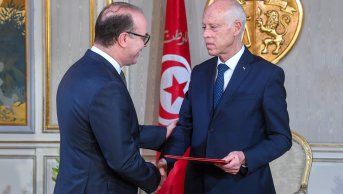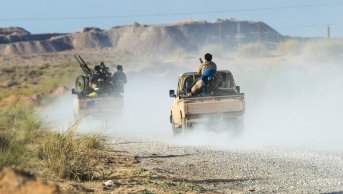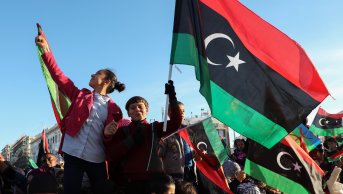Declaration of Chaos in Libya: Militias and the State

The news that Libyan Prime Minister Ali Zeidan had been abducted from his hotel room by armed gunmen on Oct.
10 drew attention to Libya. Shortly afterwards, it emerged that Zeidan had been detained by Libya's Interior Ministry for helping the US special forces capture a Libyan al-Qaeda suspect.
It appeared that the aforementioned armed men were part of militias linked to Libya's Interior Ministry. After being released later the same day of his abduction, he said during a press conference: “I am fine, thank God. The goal of the kidnapping operation was for me to present my resignation, but I won't resign.”
There are a series of tangled problems and instabilities behind Zeidan's arrest. In Libya, where the strengthening of al-Qaeda has become more visible, violence is now a part of daily life. The political figures in the country take their share of this unstable environment as much as everyday citizens. At this point, it is quite important to look at the background of the prime minister's arrest in Libya.
The civil war and militias
The state of “Libya,” which collapsed after a bloody civil war in 2011 and replaced the Socialist People's Libyan Arab Jamahiriya of Muammar Gaddafi, is still dealing with deep security problems. The priorities of the new regime established in September 2011 were to restore the political and administrative structure, provide stability, disarm the tribes and recover the economy because all administrative and political structures of the Socialist People's Libyan Arab Jamahiriya had collapsed during the civil war. When the former system in which local governments were powerful disappeared, local governments gained autonomy and became separate units by taking up arms during the civil war.
During the eight-month civil war, an uncontrolled arms flow took place into Libya to help the opposition. Gaddafi had already lost the entire or partial control of the majority of regions far from the center of Libya. The opposition seized the arms and ammunition depots in those regions. It is reported that approximately 125,000 Libyans were armed in this period.
The most significant element of this period when the armaments increased in mass is the militias consisting of rebels. When the government collapsed in Libya where the tribal structure prevailed, the armed brigades/militias gained a considerable physical and political power and contributed to the creation of many autonomous regions around small centers during the civil war. However, the end of the civil war was not enough to reverse this situation. It is believed that some 1,700 militia groups have been formed in the country since 2011, when the war began. Those small-scale autonomous power centers were supposed to be taken under state control by the new regime. But all institutions of the Socialist People's Libyan Arab Jamahiriya had been dissolved and collapsed. Therefore, it was necessary to re-establish the state in Libya, and is still necessary.
State-militia relations in Libya
The most important requirement to re-establish the state is to restore bureaucratic institutions and the military structure, which would allow for strong control to be exerted over the country In particular, taking control of the militias, which are part of the state's monopoly of violence in the post-civil war period, is one of the most significant requirements. It is extremely difficult to reach these goals in the country, where the state has completely collapsed and disputes on federalism continue, and where security is provided by local tribes. The elected governments that took office in August last year faced many problems in making progress to reach the aforesaid goals and still do.
The political tension and disputes within parliament, which have been going on since August of last year when the National Transitional Council transferred authority to the elected parliament, have a direct negative impact on the government's approach towards the security problems. The first government, which failed to receive a vote of confidence due to the political dispute, had to step down, and the new government led by Zeidan took office in October 2012. However, the new government couldn't prevent the political dispute, either. This political dispute also impedes the new regime from pursuing efficient policies to solve security problems, instability and the re-establishment of the state. Moreover, different groups within parliament keep using militia groups to gain a political advantage.
The governments formed in the post-October 2011 period tried to integrate the militia forces, which are the most significant troops of the civil war, into the new system and followed two important strategies to that end: disarmament and transforming them into military troops under the central army.
Both the pre-election National Transitional Council and also the post-election parliament and governments attempted to disarm the militia forces in the country when armament increased uncontrollably. Nevertheless, the militia forces gained considerable armament during the civil war. The majority of them have heavy combat vehicles such as tanks. In addition to their physical power, militias also institutionalized themselves by forming autonomous structures. Small-scale armed groups joined with these institutional structures in the post-civil war period. All attempts to convince militia forces to forgo their arms failed; militias that took part in the civil war refused to lay down their arms to have a say in the new period and to maintain their power.
However, the new regime tried to take these groups that were proving impossible to disarm under the command of central army. But these attempts also failed. While on the one hand, the central army was not militarily powerful enough to command the militias, on the other hand, the leading militia groups considerably resisted those attempts. As a result, the militias maintained their autonomy.
At this point, the new regime changed its strategy and granted legal status to militia forces and affiliated them with the Interior Ministry. In this way, the militia forces were transformed into military troops separate from the central army via a legal arrangement. In practical terms, this arrangement comes to mean that the state legally recognized the autonomy of militias and admitted its failure in the face of these militias. This situation is also acknowledgement that control of the country was largely taken over by the militia forces in the post-Gaddafi period. The abduction/arrest of Libyan Prime Minister Zeidan by the Interior Ministry, according to the official statement -- and by militia forces that were granted legal status and affiliated with the Interior Ministry but cannot be controlled in practice -- is the most concrete example of the current situation in Libya.





